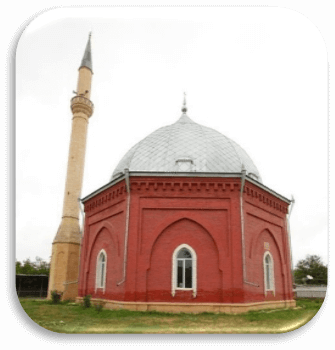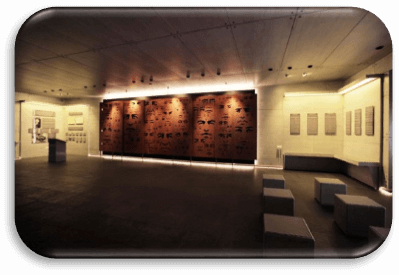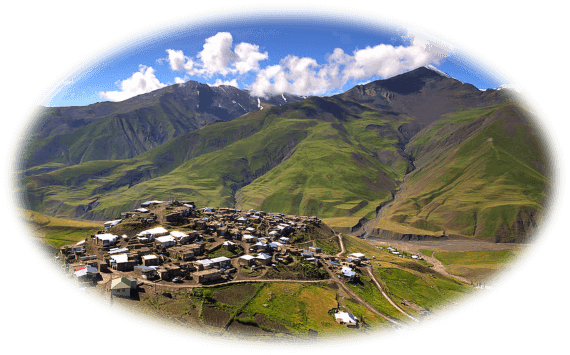Guba
Guba is one of the largest cities in Azerbaijan located 168 kilometers from Baku. The city lies on the Guba is one of the largest cities in Azerbaijan located 168 kilometers from Baku. The city lies on the  northeastern slopes of Mount Shahdag, at an altitude of 600 meters above sea level, on the right bank of the Kudialchay River. This is one of the most beautiful cities in the country. Guba is especially attractive in the spring when its many gardens and parks flourish. In Guba and its environs there are quite a lot of historical monuments. Of the architectural sights of the city, numerous mosques that have survived to our time deserve special attention.
northeastern slopes of Mount Shahdag, at an altitude of 600 meters above sea level, on the right bank of the Kudialchay River. This is one of the most beautiful cities in the country. Guba is especially attractive in the spring when its many gardens and parks flourish. In Guba and its environs there are quite a lot of historical monuments. Of the architectural sights of the city, numerous mosques that have survived to our time deserve special attention.  The house of the Guba Khan, medieval baths, a fortress of the XVth century. In addition, Guba is a famous center for carpet weaving. In the local museum of local lore, in addition to various items of material culture, you can also see skillfully made Guba carpets.
The house of the Guba Khan, medieval baths, a fortress of the XVth century. In addition, Guba is a famous center for carpet weaving. In the local museum of local lore, in addition to various items of material culture, you can also see skillfully made Guba carpets.
Red Village
Red Village or "Girmyzy Gasaba" is a small village in the north-eastern part of the Greater Caucasus Mountain Range of the Cuban region of Azerbaijan, located on the left bank of the Kudialchay River, inhabited mainly by mountain Jews. The convenient location of the village on a large trade road, the patronage of the Guba khans, the fertile land that allowed farming, contributed to the prosperity of village.  In addition to agriculture local residents were engaged in gardening and carpet weaving. Local apples are famous throughout the district, and carpet weaving has become a hallmark of the region. The preservation and development of the traditions of Orthodox Judaism is inextricably linked with the life of the Mountain Jews community. There are 7 synagogues in the village.
In addition to agriculture local residents were engaged in gardening and carpet weaving. Local apples are famous throughout the district, and carpet weaving has become a hallmark of the region. The preservation and development of the traditions of Orthodox Judaism is inextricably linked with the life of the Mountain Jews community. There are 7 synagogues in the village.  After three hundred years, Red Village has not only survived but also acquired the significance of a monument of national importance with a rich history and heritage, which many tourists from all over the world come to meet. Red Village is recognized as the center for the development and preservation of the material and spiritual culture of mountain Jews in Azerbaijan and beyond. It is no coincidence that this village is called "Jerusalem of the Caucasus."
After three hundred years, Red Village has not only survived but also acquired the significance of a monument of national importance with a rich history and heritage, which many tourists from all over the world come to meet. Red Village is recognized as the center for the development and preservation of the material and spiritual culture of mountain Jews in Azerbaijan and beyond. It is no coincidence that this village is called "Jerusalem of the Caucasus."
Sakina Khanum Mosque
It was built in the 1850s by Sakina Khanum, the widow of Abbas-Kuli-ag Bakikhanov, to perpetuate the memory of her husband. Bakikhanov who lived in Guba for a long time was a military man by his main profession, but he is known more as a historian and writer, one of the founders of Azerbaijani literature. The construction is able to impress with its monumentality. It is built of red brick and looks like a faceted cylinder. Each face wall has a window in the form of a semicircular arch. The top of the facade is surrounded by an original cornice made of small bricks. On top of this stately building is crowned with a large white metal dome similar to a helmet and also trimmed with numerous faces. The top of the dome is decorated with an elegant thin spire.
Bakikhanov who lived in Guba for a long time was a military man by his main profession, but he is known more as a historian and writer, one of the founders of Azerbaijani literature. The construction is able to impress with its monumentality. It is built of red brick and looks like a faceted cylinder. Each face wall has a window in the form of a semicircular arch. The top of the facade is surrounded by an original cornice made of small bricks. On top of this stately building is crowned with a large white metal dome similar to a helmet and also trimmed with numerous faces. The top of the dome is decorated with an elegant thin spire.
Juma Mosque (XIXth century)

In the city center, near the central park, is located one of the oldest mosques in the city - Juma Mosque (Friday Mosque), erected at the very beginning of the XIXth century. She is also called Jame. Built in a rich architectural style, the mosque was built of red brick in 1802 with the financial support of Gazi Ismail Effendi. The architecture of this religious building is typical exclusively for mosques of the Guba province. In appearance, it resembles a faceted cylinder, that is, it has the shape of a regular octagon, inside there is one large hall, crowned by a huge dome, measuring 16 meters in diameter.
Genocide Memorial
The memorial complex was erected in memory of tens of thousands of Azerbaijanis who became victims of the massacres that the Bolshevik-Armenian armed groups staged on Azerbaijani soil in 1918.  In the memorial complex, which was erected next to the mass grave discovered in Guba, a museum with a rich exhibition based on historical documents and facts was created. The monument consists of three parts: the entrance and exit in the form of two designs resembling pointed knives, the main hall, in the center of which is placed a black memorial stone.
In the memorial complex, which was erected next to the mass grave discovered in Guba, a museum with a rich exhibition based on historical documents and facts was created. The monument consists of three parts: the entrance and exit in the form of two designs resembling pointed knives, the main hall, in the center of which is placed a black memorial stone.  The museum’s exposition reflects the history of the genocide of the population of five districts of Baku province - Baku, Shamakhi, Guba, Javad and Gokchay in March-July 1918. The exposition consists of 19 sections. It begins with photographs reflecting the peaceful life in Guba on the eve of the events of 1918. Here are photographs showing the life of the old Guba, peaceful cohabitation of representatives of the Azerbaijani, Lezgin, Jewish and other peoples, people from various social backgrounds. On the territory of the museum complex there is an information center, a rich library, a reading room equipped with computers. The State Flag of the Republic of Azerbaijan has been hoisted on the territory of the complex.
The museum’s exposition reflects the history of the genocide of the population of five districts of Baku province - Baku, Shamakhi, Guba, Javad and Gokchay in March-July 1918. The exposition consists of 19 sections. It begins with photographs reflecting the peaceful life in Guba on the eve of the events of 1918. Here are photographs showing the life of the old Guba, peaceful cohabitation of representatives of the Azerbaijani, Lezgin, Jewish and other peoples, people from various social backgrounds. On the territory of the museum complex there is an information center, a rich library, a reading room equipped with computers. The State Flag of the Republic of Azerbaijan has been hoisted on the territory of the complex.
Arched Bridge (XIX century)
The only bridge that has survived to this day called Gudialchay is one of seven that existed in the Guba district.  This longest bridge was built in 1894 according to the design of Alexander III. Fourteen of its spans with a total length of 275 meters and a width of 8 m are made of fired brick. The multi-span structure allows the bridge to remain intact even during powerful mudflows and floods that raise the water level in the river. A bridge of similar construction, built in the XIXth century, is the only one in Azerbaijan. Today, from the Arched Bridge which is now used only by pedestrians offers an unforgettable view of the city. It can be easily reached from the oldest city park. Nizami to the Red Village. The bridge is protected by the state as an architectural monument.
This longest bridge was built in 1894 according to the design of Alexander III. Fourteen of its spans with a total length of 275 meters and a width of 8 m are made of fired brick. The multi-span structure allows the bridge to remain intact even during powerful mudflows and floods that raise the water level in the river. A bridge of similar construction, built in the XIXth century, is the only one in Azerbaijan. Today, from the Arched Bridge which is now used only by pedestrians offers an unforgettable view of the city. It can be easily reached from the oldest city park. Nizami to the Red Village. The bridge is protected by the state as an architectural monument.
Nizami Park - Guba's Oldest Park

The park is surrounded by greenery, fountains murmur in the shade of trees. A monument to the great Azerbaijani poet Nizami Gandjavi was erected in the park. Around the monument along the alleys are bas-reliefs depicting scenes from the works of Nizami. The central building attracting a great attention is the building of the Guba Chess School, built in September 2011. Here, all conditions have been created for the training of chess players and up to 350 athletes can simultaneously play a simultaneous game in the competition hall. You can often see tourists in the park. Having enjoyed a walk along the alleys of the park, you can go down to the old arched bridge over Gudialchay along the stairs lined with gilded sculptures - a grape picker, a girl with a ball, a young man with a tennis racket and a worker.
Bath Sukhur (XVIII century)
Baths in Azerbaijan at all times occupied a special place in the life of people, they were a favorite place to delight the body and spirit.  The building of the bathhouse, built of red brick in the XVIIIth century, is crowned by a large dome, which allowed to maintain the desired temperature and humidity in the room. This quadrangular structure is also called Sukhur (Chukhur) hammams, i.e bath built from special rocks. The building has 6 rooms, 2 doors and 6 windows. Water was supplied from a well under the bathhouse or from a city water supply. At one time, Alexander Dumas himself washed in this bathhouse during his stay in Guba, and after 150 years his great-grandson visited these places. Until 1985 the bathhouse was used for its intended purpose and was the main resting place for the Guba people. Now this pearl of oriental architecture is a historical monument.
The building of the bathhouse, built of red brick in the XVIIIth century, is crowned by a large dome, which allowed to maintain the desired temperature and humidity in the room. This quadrangular structure is also called Sukhur (Chukhur) hammams, i.e bath built from special rocks. The building has 6 rooms, 2 doors and 6 windows. Water was supplied from a well under the bathhouse or from a city water supply. At one time, Alexander Dumas himself washed in this bathhouse during his stay in Guba, and after 150 years his great-grandson visited these places. Until 1985 the bathhouse was used for its intended purpose and was the main resting place for the Guba people. Now this pearl of oriental architecture is a historical monument.
A. Bakikhanov House-Museum
Abbasgulu Aga Bakikhanov (1794-1847) - the first Azerbaijani to become a military translator, diplomat, officer of the Russian army.  A prominent historian, writer and encyclopedic scientist grew up in the village of Amsar Guba district. Abbasgulu Aga Bakikhanov is the author of five historical and literary works, the most famous of which is "Gyulistani-Iram". In this work, written in 1841 in Persian and then translated by him into Russian in 1843, the author sets out the history of Azerbaijan before the conclusion of the Gulistan Peace Treaty (1813). Abbasgulu Aga Bakikhanov Museum of Local History was founded in Guba in 1943. The museum was opened in a building of the XIX century in which Bakikhanov himself lived at one time. On the territory of the museum with a total area of 742 square meters more than 10 thousand different exhibits are stored. More than 3.000 people visit the museum annually. Every year the museum holds an action called "Spring at the Museum" as well as an open day. This museum in Guba has 2 more branches: one of them - Bakikhanov House-Museum is located in the village of Amsar and the other - the Martyrs' Memorial Museum is located in the city. Today, the museum is undergoing restoration work. A new building is already under construction in one of the points of the city, which will be relocated in the near future.
A prominent historian, writer and encyclopedic scientist grew up in the village of Amsar Guba district. Abbasgulu Aga Bakikhanov is the author of five historical and literary works, the most famous of which is "Gyulistani-Iram". In this work, written in 1841 in Persian and then translated by him into Russian in 1843, the author sets out the history of Azerbaijan before the conclusion of the Gulistan Peace Treaty (1813). Abbasgulu Aga Bakikhanov Museum of Local History was founded in Guba in 1943. The museum was opened in a building of the XIX century in which Bakikhanov himself lived at one time. On the territory of the museum with a total area of 742 square meters more than 10 thousand different exhibits are stored. More than 3.000 people visit the museum annually. Every year the museum holds an action called "Spring at the Museum" as well as an open day. This museum in Guba has 2 more branches: one of them - Bakikhanov House-Museum is located in the village of Amsar and the other - the Martyrs' Memorial Museum is located in the city. Today, the museum is undergoing restoration work. A new building is already under construction in one of the points of the city, which will be relocated in the near future.
Tyangya Alti

Mountain slopes drowning in deciduous forest, permeated by hundreds of springs flowing from the ever-gray Shahdag and sparkling merrily under the summer sun, will leave fond memories for the whole year to return you here next year.
Afurdja Waterfall

Afurdja is the highest waterfall in Azerbaijan. The height of the waterfall is 30 m. The waterfall falls down from a cliff about 30 meters high. Afurdja Waterfall begins in the mountains and leaves with a silver ribbon in the gorge. Translated into Russian "Afurdja" means a place where splashes of water fall. Afurdja Waterfall is included in the list of "Natural Monuments of Azerbaijan".
Gechresh

Gechresh is a beautiful place with absolutely stunning nature, where forests are replaced by mountain landscapes, the air is transparent, and icy water will make even the most tired traveler cheer up.
Khinalig
Khinalig is a village in the Guba region of Azerbaijan located at an altitude of 2100-2200 meters above sea level above the Kudialchay River. It is located in an inaccessible area in the south- west of the Guba region on the slope of Mount Kyzylkaya on the northern slope of the Main Caucasian Range, opposite the mountain of the same name Khinalig. Due to its inaccessibility, a peculiar language, unique architectural appearance and culture the village attracts tourists and travelers. Here you can find the Temple of Fire-Worshipers, the tomb of Khidir Nebi, the Mosques of Sheikh Shalbuz, Abu Muslim, caves and numerous unexplored archaeological sites belonging to the Middle Ages.
west of the Guba region on the slope of Mount Kyzylkaya on the northern slope of the Main Caucasian Range, opposite the mountain of the same name Khinalig. Due to its inaccessibility, a peculiar language, unique architectural appearance and culture the village attracts tourists and travelers. Here you can find the Temple of Fire-Worshipers, the tomb of Khidir Nebi, the Mosques of Sheikh Shalbuz, Abu Muslim, caves and numerous unexplored archaeological sites belonging to the Middle Ages.

The Khinalig people are a special historical attraction of the region, since this ethnic group is the descendants of the ancient Albanian tribes. To date, there are only about a thousand people left but despite this, they managed to maintain their original original language, costumes, life, traditions and rites. Khinalig is like a small state in a state that even has its own internal laws and rules. The villagers profess Islam and before Islam they were fire worshipers. This is evidenced by the temples of fire and some semi-pagan traditions that have nothing to do with Muslims. The first references to them in written sources date back to theXVIIIth century. In 2007, the village of Khinalig was declared a State Historical, Architectural and Ethnographic Reserve.

